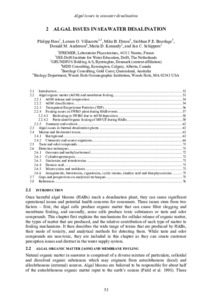Algal issues in seawater desalination.

View/
Average rating
votes
Date
2017Author
Hess, Philipp
Villacorte, Loreen O.
Dixon, Mike B.
Boerlage, Siobhan F.E.
Anderson, Donald M.
Kennedy, Maria D.
Schippers, Jan C.
Status
Published
Metadata
Show full item recordAbstract
Once harmful algal blooms (HABs) reach a desalination plant, they can cause significant
operational issues and potential health concerns for consumers. These issues stem from two
factors – first, the algal cells produce organic matter that can cause filter clogging and
membrane fouling, and secondly, some cells produce toxic substances or taste and odor
compounds. This chapter first explains the mechanisms for cellular release of organic matter,
the types of matter that are produced, and the relative contribution of each type of matter to
fouling mechanisms. It then describes the wide range of toxins that are produced by HABs,
their mode of toxicity, and analytical methods for detecting them. While taste and odor
compounds are non-toxic, they are included in this chapter as they can create customer
perception issues and distrust in the water supply system......
Title of Report
Harmful Algal Blooms (HABs) and Desalination: a Guide to Impacts, Monitoring and Management.Editor(s) of Report
Anderson, D.M.Boerlage, S.F.E.
Dixon, M.B.
Page Range
pp.53-88Publisher
Intergovernmental Oceanographic Commission of UNESCOParis, France
Series;Nr
Intergovernmental Oceanographic Commission Manuals and Guides;78Document Language
enSustainable Development Goals (SDG)
14.1Essential Ocean Variables (EOV)
Phytoplankton biomass and diversityBest Practice Type
ManualCitation
Hess, P.; Villacorte, L.O.; Dixon, M.B. et al (2017) Algal issues in seawater desalination. In: Harmful Algal Blooms (HABs) and Desalination: A Guide to Impacts, Monitoring and Management. (eds. Anderson D. M.; Boerlage, S. F. E. and Dixon, M.B.). Paris, France, Intergovernmental Oceanographic Commission of UNESCO, pp.53-88 (IOC Manuals and Guides No. 78). DOI: http://dx.doi.org/10.25607/OBP-205Collections
 Repository of community practices in Ocean Research, Applications and Data/Information Management
Repository of community practices in Ocean Research, Applications and Data/Information Management